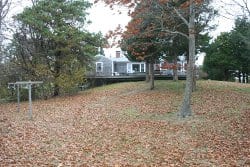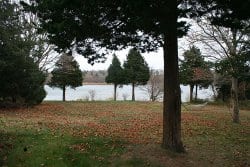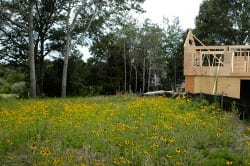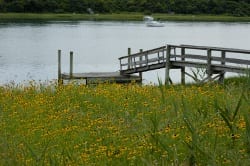by Theresa Sprague
As the landscape paradigm continues to shift towards sustainable/regenerative design, ecological function, and land management vs. landscaping, it becomes clearer that collaboration between the conservation and landscape communities is essential. In my neck of the woods (Southeastern Massachusetts and Cape Cod), where land within ecologically sensitive areas such as wetlands, coastal banks, marshes, vernal pools, etc. has been developed at a mind-boggling rate, the need for collaboration is unquestionable.

Proposed project: remove existing cottage and build a larger year-round home with stone walls and patio.
The resource areas mentioned above are regulated by the state Wetlands Protection Act and often by more stringent local wetlands regulations, as well as by the local conservation staff and commissions that uphold those regulations. As a landscape professional, my understanding of the function and sensitive nature of these resources areas, as well as the regulations that protect them, can guide me to design and implement projects that meet (and exceed) wetlands regulations performance standards, while meeting my clients’ goals and desires and providing some important education along the way. Likewise, conservation commissions and staff can benefit from a close partnership with landscape professionals through a better understanding of the design and development process, while ensuring that communication is open and that a project is completed with minimal adverse impacts from start to finish.

View of project area before permitting and construction. The resource area involved a Coastal Bank with 100 foot buffer zone and a 50 foot no-disturb zone.
Recognizing the Challenges
The first step in this process is for the landscape professional is to recognize when work is in a regulated area (resource area or buffer zone to the resource area), know what that resource area is (e.g. bordering vegetated wetland, isolated wetland, riverfront area, coastal bank, beach or dune, etc.) and understand its ecological function. The second step is knowing the regulations that protect that resource area, including what can and cannot be done there and who to contact or what process to follow to obtain the proper permits for the site. The third step is putting together a design that meets the client’s goals, satisfies the conservation regulations, and supports and enhances the ecological function of the site. Easy, right?
Well, maybe not. Often the landscape professional can feel stuck in the middle with the conservation commission and the client at opposite ends of the table. The conservation commission wants wild and untouched and the client wants gardens, views, access, etc. A difficult spot to be in, no doubt, and unfortunately one that landscape professionals and conservation staff and commissions are finding themselves in more often.
Dueling Viewpoints
A typical scenario might look like this:
A new client calls and would like to build a deck/patio/gazebo/shed and maybe some gardens, with roses and wisteria (to climb the gazebo, of course). You arrive on the site for an initial meeting and discover – uh oh – the client lives on a pond (or a marsh, river, coastal bank etc.) surrounded by thick vegetation, a mix of native and invasive species. And, you discover that they would like their new landscape designed and built just between the house and the pond, all within 100 feet from the wetland resource area.
Now what? Should you go ahead and design and build what the client has asked for? Can you clear all that vegetation (most of it is invasive anyways)? Maybe the client wants a view or a path to the pond, and all that thick vegetation is in the way. You think that there are restrictions on what can be done around a pond, but you’re not sure what you need to do or whom to call.
Or, down at that other end of the table, you are the Conservation Agent, who has been called by a well-meaning citizen, just to let you know that their neighbors have cut all the vegetation from around their pond shoreline and put up a gazebo. You know that no permit has been issued for a project in the neighborhood. You march on down for a conversation with the property owners, and they tell you they hired someone to do the work. You give the landscaper a call, and she tells you, “Sure I did the work. A conservation permit? No, I didn’t realize I needed a conservation permit? The contractor got a building permit to put up the gazebo; I just did the landscaping.”

Site after lawn removal and initial invasive species management. Newly seeded meadow is shown during first growing season.
Learning to Turn Conflict into Collaboration
It’s a frustrating scenario for both parties, and one that I have come across many times in my professional practice. However, through communication and collaboration, these frustrations can be avoided, and everyone’s goals (including the clients!) can be met.

Seeded meadow, shown during first growing season, extends to water’s edge where there is ongoing invasive species (phragmites) management.
On March 7, 2012, the Ecological Landscape Alliance held an intensive workshop titled “Pro”active Protection of Wetlands: Conservation and Landscape Professionals Collaborate, which was intended to bring conservation and landscape professionals together to share ideas and learn from one another while exploring the fundamentals of wetlands permitting and delving into what is required in a solid landscape and land management plan.
During this workshop, participants, including landscape professionals, property owners, conservation agents, commissioners, and others discussed their experiences and examined how these different stakeholders can work together to be “Pro” active in ensuring our common goal of preserving the ecological integrity of some of our most sensitive landscapes. The conclusion was that education, collaboration, and communication are key.
Education includes recognizing the different resource areas and understanding their ecological function so that proposed plans move beyond “no adverse impacts” towards supporting that function and improving the resource area’s integrity.
Collaboration was defined as building a team of professionals including property owners, designers, engineers, contractors, land managers, and conservation professionals who consult one another as a project is developed in order to be sure that the final project meets regulations as well as the client’s goals and needs.
Communication, last but certainly not least, is arguably the most important element in the successful outcome of a project. Conservation Staff and Commissioners, design professionals and property owners must maintain open lines of communication from the conceptual stages of a project straight through to receiving a final Certificate of Compliance. Design plans and project narratives should be communicated to Conservation Staff and Commissioners clearly and concisely with no ambiguity in the project goals. Conservation Staff and Commissioners should be open to listening to and understanding the proposed plans and the expertise of the professionals who are designing those plans, as well as providing clear and useful feedback based on local and state regulations.
Workshop participants concluded that with these key elements – education, communication and collaboration – we can indeed successfully work together to not only protect, but to also support and enhance the function of our ecologically sensitive landscapes.
Note: This article was originally published before the 2012 ELA Conference & Eco-Marketplace. After the Conference, the last section of the article was revised to incorporate the Conference experience.
About the Author
Theresa Sprague is the owner of BlueFlax Design in Mattapoisett, MA, where she focuses on merging science with the fine art of landscape design to create beautiful, ecologically sound, and sustainable landscapes, restoring ecological function and integrity to the built environment. She seeks to create habitats that support the needs of both people and wildlife. Theresa holds a Masters Degree from the Conway School of Landscape Design and has over 15 years of planning, design, ecological restoration, gardening, and land management experience. She may be reached at theresa@blueflaxdesign.com.

